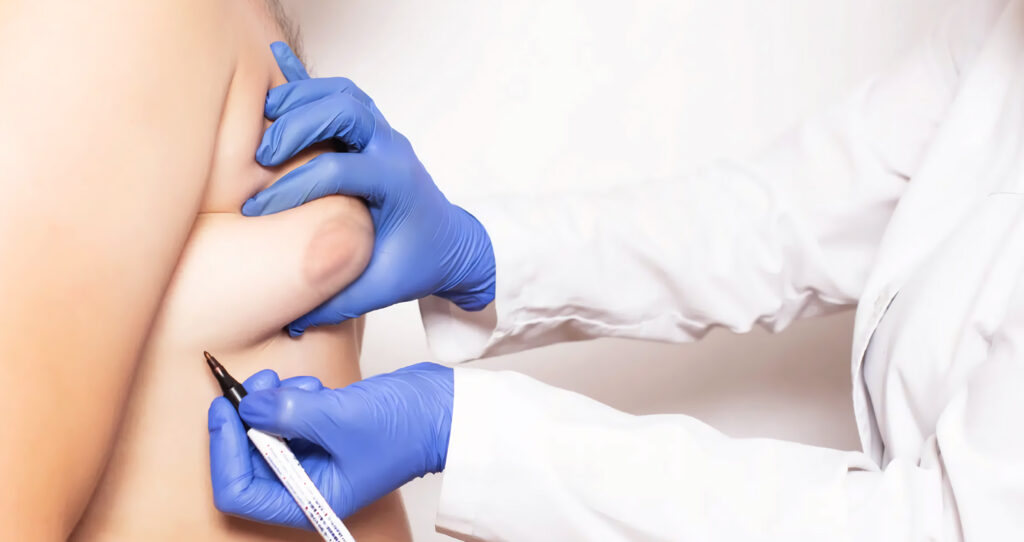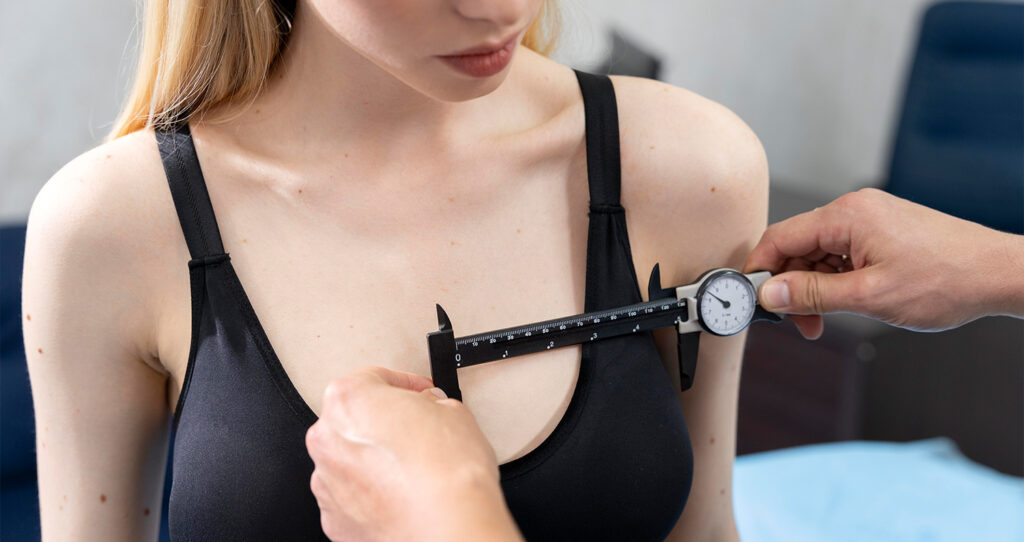How often do women experience back pain, self-esteem problems, or difficulty finding clothes that fit well due to large breasts? These are common issues faced by women around the world, leading to both physical discomfort and emotional distress. Fortunately, there’s a solution: breast reduction surgery. Advancements in technology have made breast reduction a safer and more comfortable procedure for patients. As a result, a rising number of women are opting for this procedure, and the number grows year after year [2].
To get a deeper understanding of breast reduction surgery, we spoke with Dr. Alexandre Charão, board-certified plastic surgeon with over 20 years of experience under his belt. In the interview, he shared with us his signature techniques, discussed what patients can expect during recovery, and told us how much this surgery can cost at his clinic, including what’s covered in the price. Dive deeper into Dr. Charão’s insights and learn more about breast reduction surgery in our comprehensive article.

What Is a Breast Reduction?
Breast reduction, or reduction mammoplasty, is helping women improve their quality of life. Every year more and more women agree to this operation, whether for medical or cosmetic reasons. All because modern methods of surgery and the postoperative period have become safer and more comfortable compared to the past.
The breast reduction procedure itself involves the removal of excess tissue, fat, and skin, as well as nipple displacement and, in some cases, reduction of aureoles. It can alleviate pain and discomfort, and make exercising and finding clothes that fit much easier.
What Makes You a Candidate for Breast Reduction?
While cosmetic reasons can be a motivator, we’re seeing a rise in young women seeking breast reduction for medical reasons. If you are experiencing any of the symptoms listed below, reduction mammoplasty could be a solution worth exploring.
Unpleasant symptoms that large breasts can cause:
- Pain in the back, lower back, shoulders, or neck;
- Rashes or irritation under the breasts;
- Difficulty or inability to exercise;
- Numbness in the chest or other parts of the body;
- Shortness of breath or difficulty breathing;
- Emotional distress and a negative impact on self-confidence due to breast size are also valid reasons to consider breast reduction.
Preparation Steps

Source: Thirdman from Pexels
When you have already decided to go for surgery, it is worth remembering to prepare your body for it. It all starts with a consultation with a board-certified plastic surgeon.
At the consultation, your doctor and you will discuss your desired result, you will be prescribed a diet and told about the preparation period.
In Dr. Alex’s case, he has the training system that he shared with the Bellezie team:
“Ideally, the patient would be at a healthy weight. Before surgery, I recommend a nutritional consultation with my dietician to optimize health and reduce inflammation. 4-5 months before surgery, patients should begin following the preparatory steps outlined during the initial consultation. This includes smoking cessation and other healthy lifestyle modifications.
The success of the surgery is highly dependent on the patient’s preparation. Fortunately, I have a team of experts including a dietician, physiotherapist, and nurse to support patients throughout the process.”
— Dr. Alexandre Charão to Bellezie
How Is Breast Reduction Performed?

Source: Freepik
Let’s delve into the procedure itself. Breast reduction surgery, typically lasting 3-4 hours, is performed under general anesthesia. During the surgery, the surgeon uses one of the techniques that are listed below. The ultimate goal is to alleviate the physical discomfort associated with large breasts and improve self-esteem.
Breakdown into Different Techniques
There are several techniques used for breast reduction surgery, each suited to individual needs. The surgeon will choose the most appropriate method based on the amount of tissue to be removed, desired breast shape, and nipple placement. Here’s a breakdown of the four most common techniques.
🍭 Vertical or Lollipop
This technique involves two incisions: one around the areola and another running vertically down from the bottom of the areola to the crease beneath the breast. It’s ideal for moderate reduction and some lifting, particularly for those with noticeable sagging.
⚓ Inverted T or Anchor
This is the most common and versatile technique. It creates an incision pattern resembling an inverted T or anchor shape. This allows for significant reduction, reshaping, and nipple repositioning, making it suitable for women with larger breasts.
💉 Liposuction
This is a minimally invasive option suitable for women with mostly fatty tissue and good skin elasticity who desire a moderate reduction. Liposuction removes excess fat but doesn’t address sagging or alter the nipple position.
🧑 Signature method of Dr. Alexandre
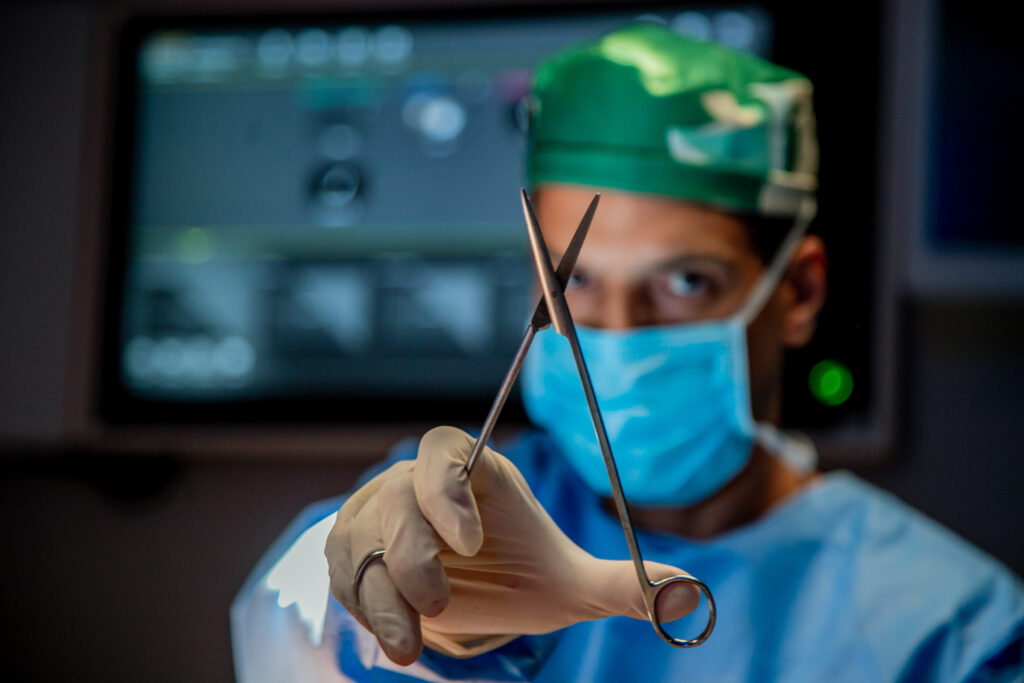
“In addition to our traditional methods, we offer a short-scar technique for breast reduction. Previously, breast reduction resulted in long scars extending from the middle of the breast to the armpits. Thankfully, this technique reduces scar length by 50%. This method also promotes more stable results over time.
For women with large breasts who are hesitant about implants due to past experiences, we can utilize their fat for volume enhancement in the upper breast. This addresses a common concern and allows us to achieve a fuller upper pole using fat grafting.”
— Dr. Alexandre Charão
Before and After Results
It’s important to have realistic expectations about the outcome. While breast reduction can significantly improve breast size and shape, it won’t completely eliminate stretch marks or create a perfect, symmetrical look. Maintaining a healthy weight after surgery is essential to sustain the desired results.
In these pictures, you can see different cases of breast reduction and how the doctor was able to help the patients.
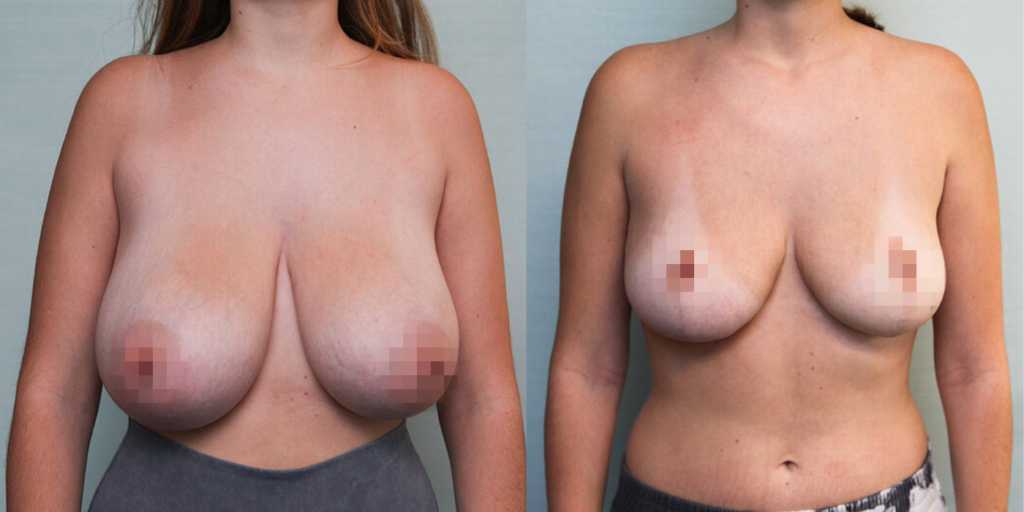

Benefits & Risks: What to Expect After Surgery?
Breast reduction surgery offers a range of potential benefits, from relief from physical discomfort to a renewed sense of confidence. However, as with any medical procedure, it’s important to be aware of the associated risks and what to expect during the breast reduction recovery process. This section will explore both sides of the coin, helping you make an informed decision about whether breast reduction is the right path for you.
Let’s take a look at a list of the breast reduction values:
- Reduced physical pain
- Improved physical activity
- Enhanced body image and self-confidence
- Relief from skin irritation
- Balanced and proportionate body shape
- In some cases, breast reduction can improve a woman’s ability to breastfeed by allowing for better positioning and latching.
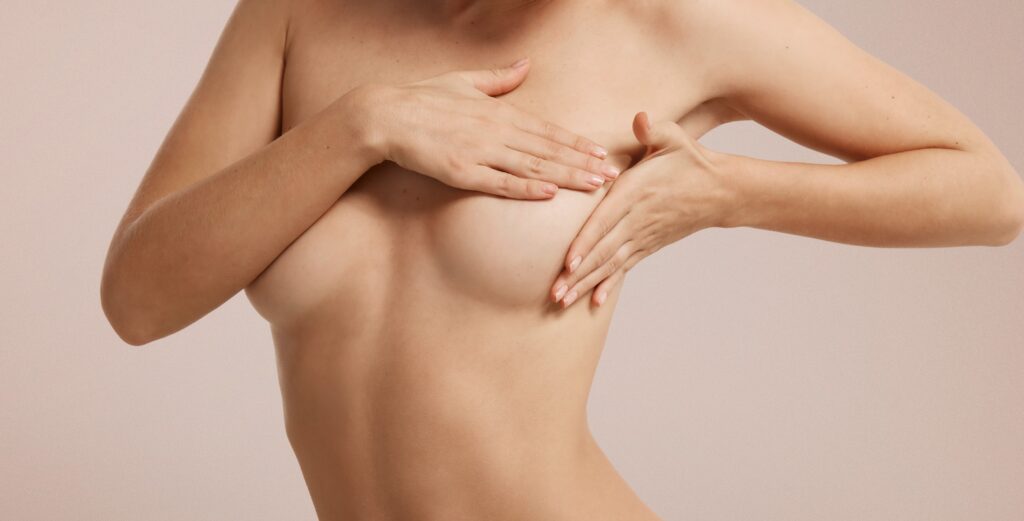
Source: Freepik
There are also some breast reduction risks to consider:
- Scars, though they may fade over time, will not disappear completely. However, there are techniques to minimize scar formation, such as Dr. Alexandre’s three-step protocol mentioned earlier. The final appearance of scars can take up to a year to develop fully.
- Changes in nipple sensation. You may experience temporary numbness or a decrease in nipple sensation after surgery. This is because nerves around the nipple can be affected during the procedure. The sensation usually improves over time.
- Some techniques might make breastfeeding ability more difficult. Be sure to discuss your desire to breastfeed with your surgeon during the consultation to understand the potential limitations and explore alternative options if necessary.
- While uncommon, bleeding might occur within 24-48 hours after surgery. Infection is also a possibility during the healing process, so it’s important to watch for signs like redness, swelling, and fever.
- Very rarely, slight breast asymmetry may occur.
Breast Reduction Afterwards

Source: Freepik
Following breast reduction surgery, there’s a recovery roadmap to ensure proper healing. Dr. Alexandre emphasizes a key element: rest. For the first 15 days of the post-operative breast reduction surgery period, patients should focus on light activity and avoid strenuous tasks like exercise or heavy lifting. Gradually, things progress towards a more normal routine. By day 30, most activities can be resumed, and by day 45, including exercise.
Dr. Alexandre also has a three-step protocol to minimize scarring:
- Using a special four-layer suture technique that distributes tension away from the skin’s surface.
- Applying surgical glue to stabilize the skin during healing.
- Early implementation of physiotherapy to promote proper healing and reduce scar tissue formation.
In some cases, silicone tape may be added for additional scar minimization. It’s important to note that individual healing can vary, and consulting with a qualified surgeon is essential to establish a personalized recovery plan.
❗ Dr. Alex’s clinic takes the issue of pain after breast reduction surgery very seriously. After all, women are often unable to do light housework or pick up their baby after surgery. However, Dr. Alex’s methods make it possible to remove pain in a short time and lift your arms as soon as 2 days after breast reduction.
“I have developed my post-operative methods that involve a rapid recovery with no pain and a recovery with a thin scar.”
— Dr. Alexandre Charão
How Much Does the Breast Reduction Surgery Cost?

Source: Freepik
Several factors influence the total breast reduction costs, including your surgeon’s experience (reflected in their fees), the hospital or surgical center’s facility fees, the type of anesthesia used (general anesthesia typically costs more than local anesthesia), the materials and equipment used during surgery, and even the surgeon and facility’s geographical location.
Dr. Alexandre offers some insights into the cost breakdown in his clinic:
His medical team’s fees typically fall around $6,000.
Hospital charges can range from $1,000 to $1,500.
Summary
Breast reduction is a type of bust plastic surgery that helps women to lighten their lives, and become more confident. In this article, we’ve explored various aspects of the surgery, including its benefits and risks, with valuable insights from Dr. Alexander. Additionally, we’ve provided the cost of breast reduction which you can expect at Dr. Alexander’s clinic.
By understanding the potential outcomes, including post-surgical breast appearance and scarring, you’re well-equipped to make an informed decision about whether breast reduction aligns with your goals. We hope this comprehensive exploration empowers you to choose the path that best suits your needs.
FAQ
😱 Is a Breast Reduction Painful?
You won’t experience any discomfort throughout the procedure because a general anesthetic is used during it. Following the procedure, you can feel some degree of pain and discomfort. Nonetheless, you can manage it better if you take your medicine as prescribed and adhere to the surgeon’s instructions. For example, techniques like Dr. Alexandre’s aim to minimize post-operative pain.
📸 How to Take Photos of Your Breasts?
Dr. Alexandre emphasizes the importance of following specific instructions for pre-consultation photos. He offers to share a link with detailed guidelines after your consultation. Here’s a general idea of what you might expect: no selfies, clear lighting, supportive bra, and multiple angles.
💰 Can Insurance Cover the Breast Reduction?
Just like breast augmentation surgery, breast reduction surgery is generally not covered by insurance.
⏳ How Long Does Breast Surgery Last?
Breast reduction surgery typically takes 3-4 hours under general anesthesia.
⚖️ What Are the Late Effects of Breast Reduction?
Breast reduction offers long-term benefits like improved physical health, confidence, and potentially better breastfeeding. While there can be late effects like breast reduction scars or changes in sensation, consulting your surgeon throughout the process helps ensure a smooth recovery and lasting positive results.
🤔 When Does the Health Insurance Pay for a Breast Reduction?
Breast reduction may be covered by insurance if deemed medically necessary. This typically requires documentation from your doctor showing large breasts cause health problems (chronic pain, breathing difficulty) and that conservative treatments haven’t helped.
References
1. Breast reduction Before & after photos | Dr. Joseph O’Connell. (n.d.). Plastic Surgery in Westport, CT | Dr. Joseph O’Connell. https://www.plasticsurgeryct.com/gallery/breast/breast-reduction/
2. American Society of Plastic Surgeons. (2022). Plastic Surgery Statistics Report. https://www.plasticsurgery.org/documents/News/Statistics/2022/plastic-surgery-statistics-report-2022.pdf


